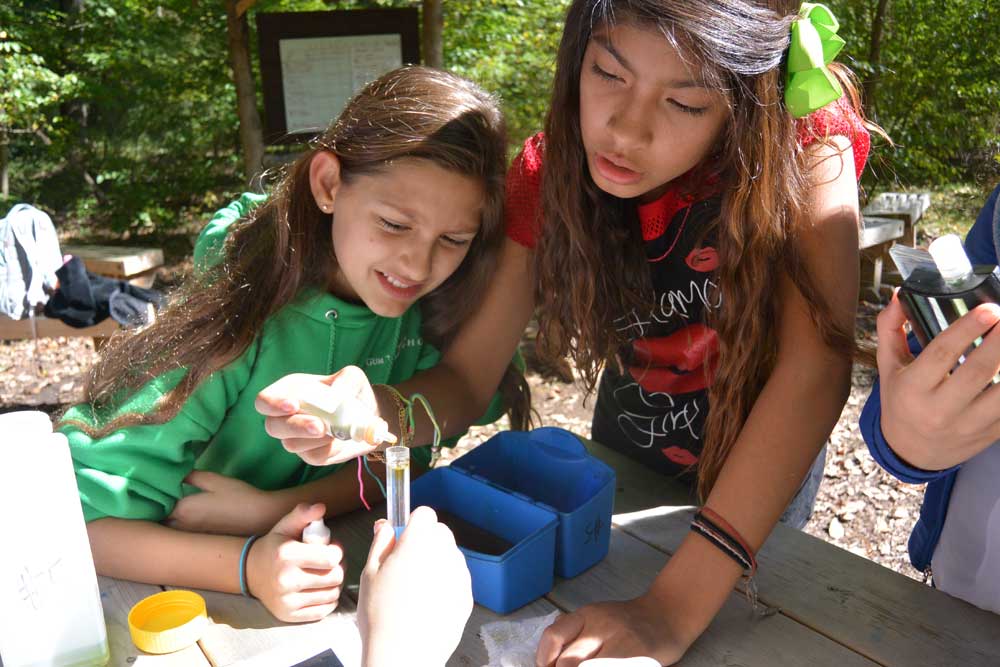
“Many students and teachers informed me that this was one of the best field trips that they have ever been on, and I have to agree. I am delighted that we are continuing this partnership.” — Michael G. Garvin, assistant principal, Avon Grove Intermediate School
By Diane M. Huskinson (This story originally appeared in the 2016 Annual Report.)
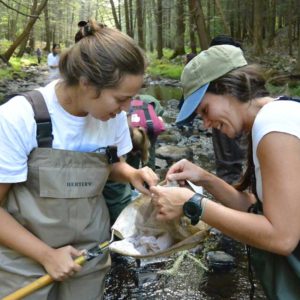
The Stroud Center has been teaching Stream School to citizens across the country for more than 20 years. With new partnerships with the Master Watershed Stewards and Pennsylvania Forest Stewards, this training is preparing more
citizens than ever before in Stroud Center history to become ambassadors for their watersheds.
On a bright, clear morning in early October, first one, then two, yellow buses pull into a parking lot tucked within the forested countryside of Chester County, Pennsylvania. The buses have arrived at Stroud™ Water Research Center in Avondale. When the doors squeak open, dozens of schoolchildren, accompanied by teachers and parents, spill out and are greeted by educators who will lead them on a four-hour journey to investigate the health of White Clay Creek and learn how to protect their local streams.
The Stroud Center’s education staff affectionately calls multiple busloads of schoolchildren, all arriving at the same time and buzzing with energy, a swarm. It’s the same term scientists use to describe mayflies — a hallmark of healthy waterways — dancing above a stream
In 2016, the Stroud Center engaged more children and adults in face-to-face programs than in any previous year: about 5,800, up from 1,800 in 2015.
Education Director Steve Kerlin, Ph.D., says, “Our goal is to engage about 10,000 children and adults in our programs on a yearly basis by 2020 and sustain that number into the future.”
Working toward that goal, the education department added five part-time environmental educators last spring. In total, the education department’s staff boasts more than 200 years of combined teaching experience.
Stream School Programs for Students
Bill Anderson, a retired high school advanced biology teacher and an adjunct research associate, is among them: “In the last two years, especially in 2016, the number of students coming to the Stroud Center has skyrocketed. It seems like the parking lot is full every day with buses of students. I can’t tell you how gratifying it is to see this part of the Stroud Center’s mission becoming realized, especially with the new building. It’s such a marvelous place for the kids to get hands-on experience in the stream with experts in watershed science.”
The new building is the Moorhead Environmental Complex, a LEED Platinum green building and demonstration grounds for education and public outreach that opened its doors in 2012.
Anderson says, “Sometimes a parent or student will say, ‘Thanks, mister. This is the best time we’ve ever had in school,’ or something like that, and boy, you get a couple of those a month, and that’s all you need!”
What makes the Stream School programs so appealing and engaging has a lot to do with connecting students to nature. Students typically rotate through four different learning modules. Anderson teaches the water chemistry module, where students learn about things like pH and dissolved oxygen.
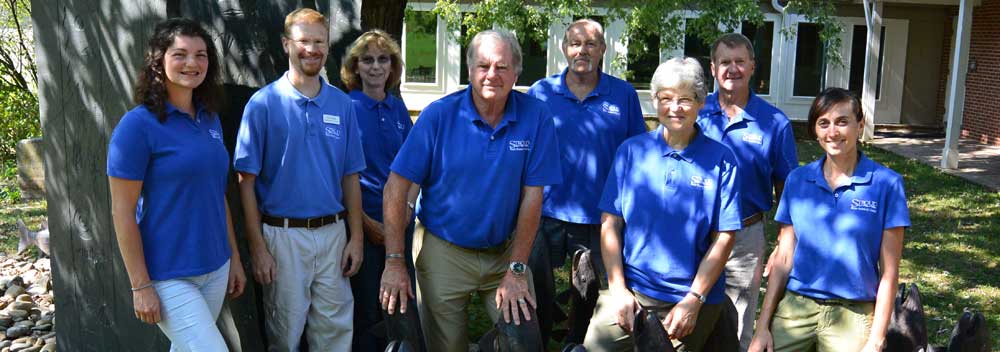
Reaching thousands more students and adults than ever before with a variety of environmental science programs, the Stroud Center’s education department grew from three to eight staff in 2016. They boast more than 200 years of combined teaching experience.
“They can learn water chemistry in their school classrooms, but they won’t come away with the same appreciation for their environment if the water sample they are testing is coming from the tap,” he says. “When they come here, they’re putting on rubber boots and carrying buckets to collect water directly from an actual stream.”
The second module has the students going into White Clay Creek, the research stream that flows behind the Stroud Center, where they turn over rocks and look for critters they will later take back to the indoor education lab and put under microscopes to identify what species they have found. The third involves an exploration of stream habitat and flow during a nature walk.
“This is when they practice their observational skills,”Anderson explains. “We ask them, ‘What do you notice about the trees? How big are they? Do the trees come right down to the edge of the stream? Are there trees that have fallen over into the stream?’”
These questions help the students identify features scientists look for in streams that have good water quality and support native biological diversity.
Anderson says, “During the four hours they are here, we must capture their attention and their enthusiasm. As an educator, you have to be a bit of an entertainer to inspire them. It’s challenging, but it’s also rewarding and fun. If you are a career educator like me, you never turn down an opportunity to work with kids.”
The last module is a guided tour of the sustainable building and grounds, including features such as constructed wastewater wetlands, rain gardens, vermiculture composting, a green (vegetated) roof, and geothermal and solar utilities. For many students, a highlight is also visiting the science labs, where they see scientists at work and the kinds of research studies that are in progress. As part of the tour, they also walk through the streamhouse on the glass bridge that connects the research labs to the Moorhead Environmental Complex.
Reaching Beyond the K-12 Classroom
School groups aren’t the only audience to benefit from the Stroud Center’s knowledge about freshwater science. Within the last year, Kerlin and the education staff have expanded their efforts to reach more children and adults with a variety of fun programs. The Stroud Center now offers day and overnight scout programs, as well as trout-release programs for children and their families.
Additionally, the education department is partnering with universities, the Chester County Intermediate Unit, and other Stroud Center staff to provide professional development workshops for teachers, watershed science education for undergraduate and graduate students, and training for citizen scientists and watershed professionals.
“In 2016, we began offering inquiry-based professional development for educators that includes webinars on WikiWatershed.org and the Leaf Pack Network®,” says Kerlin. WikiWatershed® is an online toolkit redesigned and relaunched in 2016. “We’ve had dozens of educators from across the country participate, and with what they’ve learned, they will be able to use these tools in their own outdoor classrooms and communities.
Millersville University Professor Nanette Marcum-Dietrich, Ph.D., is helping to oversee the development of the new Watershed Education Training Institute at Millersville: “We wanted to bring in school groups and train teachers, but we don’t have the manpower here to run the program, so we looked to Steve Kerlin at the Stroud Center and asked, ‘Can you come in and fill this gap?’”
Marcum-Dietrich says she also had the opportunity to bring her own children to one of the trout-release days last spring.“My kids loved it. And my son was involved in the Stroud Center’s first Cub Scout overnight trip. That was probably one of their favorite activities this year. To hear them talk about the eel they caught: ‘It was the biggest one ever!’ The exploring was so much fun for them. And they loved knowing that real scientists work there. They’re not just reading about science in a textbook. That’s the neat part about the education programs: the students aren’t going to a nature center or a park; they’re going to a research center where science is happening.”
Watershed Science Goes High-Tech
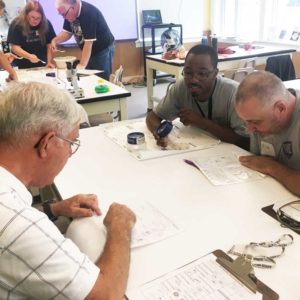
Educators learn to identify macroinvertebrates at a Leaf Pack Network workshop, one of several opportunities the Stroud Center offers to educators seeking professional development training and credits.
While getting children and adults outside and into streams to learn watershed science is integral to the Stroud Center’s education programs, so too is technology. “Technology, particularly mobile technology, plays an important role in science and how we gain knowledge about our environment. Plus children and adults enjoy using technology, so it’s a win-win,” says Kerlin.
One example is the Water Quality mobile app, which lets educators and citizen scientists create a digital lab report of stream data and then provides learning pop-ups to help users make sense of the data they collected. Previously, it was only available for Apple Devices. It is now available for Android tablets and smartphones too.
Another example: Model My Watershed®, one of the WikiWatershed web tools. “Last school year, we recruited about 75 teachers in five states to pilot a watershed curriculum that incorporates Model My Watershed,” Kerlin says. The web tool developed by the Stroud Center and technical partners allows users to select any geographic area in the continental United States, choose from a variety of land-use changes, and then predict the impact on stormwater runoff and water quality.
“It’s an exciting time. We’re reaching more people than ever before with our watershed science and education, and we’re not done yet!”
If there’s one thing Anderson wants people to take away from an education experience through the Stroud Center, it’s that the entire stream ecosystem should be treated as a living thing that is sensitive to outside forces: “It’s like when you go to the doctor, and the doctor takes your vitals. Science tells you the vital signs of a stream. And more broadly, I hope we are teaching people to become more interested in their natural environment and giving them the knowledge and tools to make a positive impact in their schools and communities. Not everyone needs to be a scientist, but everyone needs to be a citizen scientist.”
The Outdoor Classroom
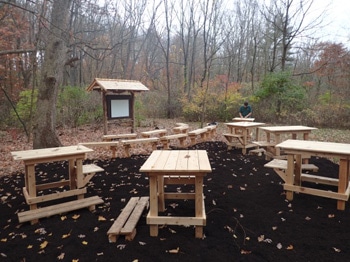 Located just a short walk upstream, the Stroud Center’s new outdoor classroom includes rustic-looking benches, lab tables, and an education kiosk that seem to naturally grow out of the woodland setting. The vision for the classroom came from Assistant Director of Education Tara Muenz, who saw a need to enhance the learning experiences for visiting students: “The classroom is all around us, but at the outdoor classroom, we can now provide infinite opportunities to learn and do real science within close proximity to the creek. It’s a fun space that will continue to grow, and it’s already a great model that other institutions are recreating.” The innovative design of the education kiosk, which uses environmentally friendly materials, is the result of an Eagle Scout project by Payton Shonk of Boy Scout Troop 23 in Downingtown. Stroud Center Assistant Director Dave Arscott, Ph.D., crafted the benches and lab tables from cedar.
Located just a short walk upstream, the Stroud Center’s new outdoor classroom includes rustic-looking benches, lab tables, and an education kiosk that seem to naturally grow out of the woodland setting. The vision for the classroom came from Assistant Director of Education Tara Muenz, who saw a need to enhance the learning experiences for visiting students: “The classroom is all around us, but at the outdoor classroom, we can now provide infinite opportunities to learn and do real science within close proximity to the creek. It’s a fun space that will continue to grow, and it’s already a great model that other institutions are recreating.” The innovative design of the education kiosk, which uses environmentally friendly materials, is the result of an Eagle Scout project by Payton Shonk of Boy Scout Troop 23 in Downingtown. Stroud Center Assistant Director Dave Arscott, Ph.D., crafted the benches and lab tables from cedar.
Learn More
Our educators have developed extensive resources for educating adults and youths about watersheds and their importance. On-site and off-site school and scout programs, professional development workshops, and community and family programs are just some of the available options.

